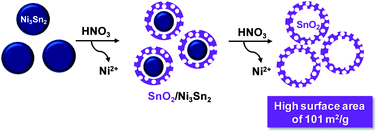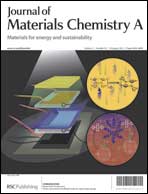This work shows that a chemical bottom-up and successive top-down approach is a good synthetic strategy for nanoporous hollow materials. The heating of 3 eq. nickel chloride and 2 eq. tin chloride at 280 °C in the presence of oleylamine resulted in the formation of intermetallic Ni3Sn2 alloy materials. According to mechanistic studies, zerovalent nickel formed by the reduction of precursor induced the reduction of the tin precursor to form Ni3Sn2 alloys. The Ni3Sn2 nanoparticles were characterized by SEM, TEM, PXRD and EDS. When the Ni3Sn2 nanoparticles were treated with 1% nitric acid for 48 hours, the nickel component was completely etched. The resultant materials were nanoporous SnO2 hollow materials, which were characterized by TEM, PXRD and XPS. Due to the nanoparticulate characteristics of shells, BET analysis on the SnO2 hollows showed nanoporosity and a high surface area of 101 m2 g−1. The hollow SnO2 materials with nanoparticulate shells showed excellent photocatalytic activities in the decomposition of Rhodamine B. Moreover, they showed promising electrochemical performances with a discharge capacity of 560 mA h g−1 after 30 cycles and stabilities as anode materials in lithium ion batteries. The preparation of a multi-component alloy and the selective etching strategy can be further expanded to other intermetallic alloy systems for the development of functional materials.

You have access to this article
 Please wait while we load your content...
Something went wrong. Try again?
Please wait while we load your content...
Something went wrong. Try again?


 Please wait while we load your content...
Please wait while we load your content...